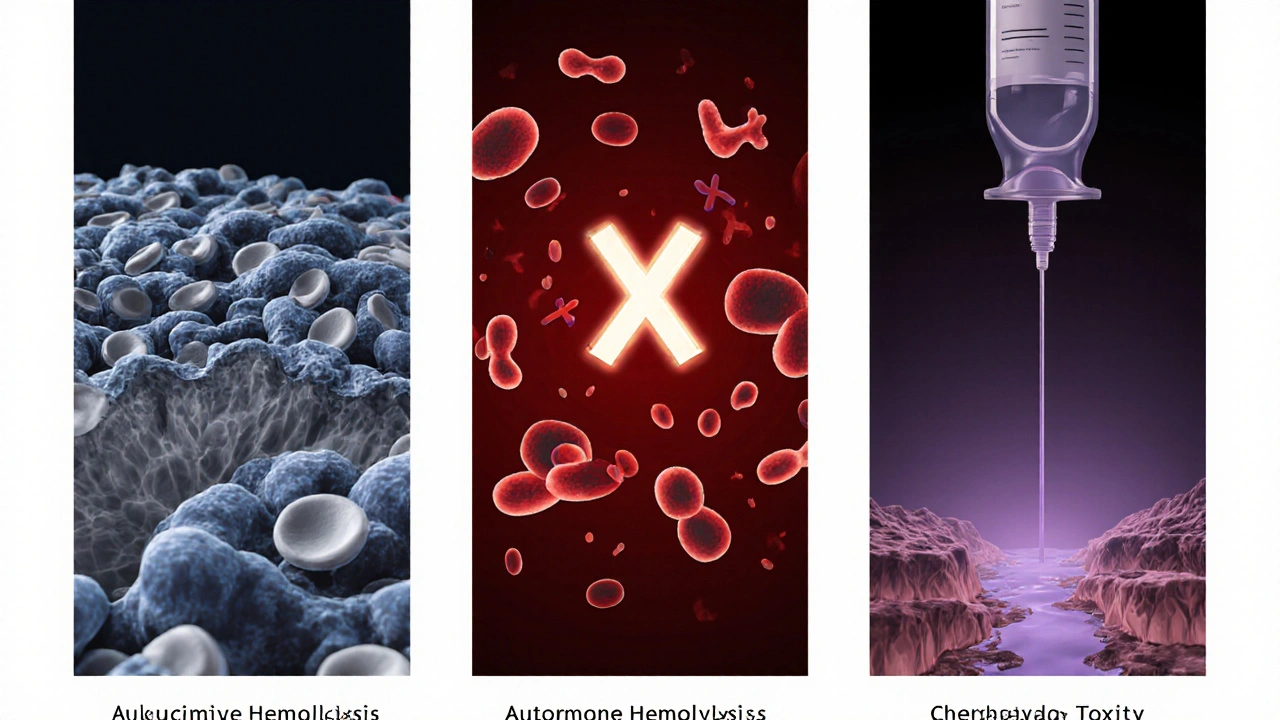CLL-Related Anemia Symptom Checker
Symptom Assessment
Answer the following questions about your symptoms to assess the likelihood of anemia in the context of Chronic Lymphocytic Leukemia (CLL).
Assessment Results
Understanding the link between chronic lymphocytic leukemia and anemia is crucial for patients, caregivers, and clinicians alike. When CLL interferes with blood production, the resulting anemia can deepen fatigue, worsen infections, and complicate treatment decisions. This guide breaks down why the two conditions often appear together, how to spot the warning signs, and what steps can keep you or a loved one feeling as normal as possible.
Quick Takeaways
- CLL can cause anemia through bone‑marrow infiltration, immune‑mediated destruction, and chemotherapy side effects.
- Three main anemia types in CLL are autoimmune hemolytic anemia (AIHA), anemia of chronic disease, and treatment‑related anemia.
- Key symptoms include persistent fatigue, shortness of breath, pale skin, and rapid heart rate.
- Diagnosis relies on CBC, reticulocyte count, Coombs test, and sometimes bone‑marrow biopsy.
- Management blends CLL‑directed therapy, steroids, transfusions, and lifestyle tweaks such as nutrition and gentle exercise.
What Is Chronic Lymphocytic Leukemia?
Chronic Lymphocytic Leukemia is a slow‑growing cancer of mature B‑cell lymphocytes that primarily accumulates in the blood, bone marrow, and lymph nodes. Unlike aggressive leukemias, CLL often presents without symptoms and is discovered during routine blood work. Over time, the excess lymphocytes crowd out normal blood‑forming cells, weakening the immune system and increasing infection risk.
How CLL Can Trigger Anemia
The relationship between CLL and anemia isn’t a one‑size‑fits‑all story. Three core mechanisms explain the connection:
- Bone‑marrow infiltration. As malignant lymphocytes settle in the marrow, they physically displace red blood cells precursors and hinder their production.
- Autoimmune hemolysis. CLL can provoke the immune system to produce antibodies that attack the body’s own red blood cells, leading to premature destruction.
- Treatment‑related toxicity. Chemotherapy agents such as fludarabine and monoclonal antibodies like rituximab suppress the bone‑marrow’s ability to generate new cells.

Types of Anemia Seen in CLL Patients
Not all anemia in CLL looks the same. Below is a quick comparison of the three most common forms.
| Feature | Autoimmune Hemolytic Anemia (AIHA) | Anemia of Chronic Disease (ACD) | Treatment‑Related Anemia |
|---|---|---|---|
| Cause | Antibody‑mediated RBC destruction | Iron sequestration & impaired erythropoiesis due to inflammation | Cytotoxic impact on marrow from chemo/targeted agents |
| Lab clues | Positive Direct Coombs, high LDH, low haptoglobin | Low serum iron, high ferritin, normal/low reticulocyte count | Drop in all blood lines, often concurrent neutropenia |
| Typical onset | Often early‑to‑mid disease, can be triggered by infections | Occurs in later stages when disease burden is high | Within weeks of starting chemo regimens |
| First‑line treatment | Glucocorticoids, rituximab, splenectomy in refractory cases | Address underlying CLL, erythropoiesis‑stimulating agents | Dose adjustments, growth factor support, transfusion if needed |
Signs & Symptoms to Watch For
Because fatigue is already a hallmark of CLL, distinguishing anemia‑related tiredness can be tricky. Look for these clues:
- Persistent, worsening fatigue that doesn’t improve with rest.
- Shortness of breath during everyday activities (climbing stairs, light housework).
- Pale or yellowish skin, especially on the inner eyelids.
- Rapid heartbeat or palpitations at rest.
- Dark urine or jaundice, which may hint at hemolysis.
If any of these appear suddenly or intensify, it’s time to get a full blood count checked.
How Doctors Diagnose Anemia in CLL
The work‑up blends routine labs with targeted tests:
- Complete blood count (CBC). Looks for low hemoglobin, hematocrit, and reticulocyte response.
- Peripheral blood smear. Evaluates RBC shape, presence of spherocytes (AIHA clue), or nucleated RBCs.
- Direct Coombs test. Detects antibodies bound to RBCs; positive in AIHA.
- Iron studies. Serum iron, ferritin, and total iron‑binding capacity differentiate AIHA from anemia of chronic disease.
- Bone‑marrow biopsy. Reserved for ambiguous cases; checks for marrow infiltration and overall cellularity.
Managing Anemia While Treating CLL
Effective anemia control hinges on tackling the root cause and supporting red‑cell production.
Targeting the underlying leukemia
Modern CLL regimens-such as ibrutinib (a BTK inhibitor) or venetoclax-can reduce lymphocyte load and improve marrow space. When these agents lower disease activity, anemia often improves without additional intervention.
Autoimmune hemolytic anemia therapy
First‑line steroids (prednisone 1mg/kg) halt immune attack in most patients. If steroids fail, adding rituximab (anti‑CD20 antibody) produces durable remission in many cases. Splenectomy is a last resort for refractory AIHA.
Supportive measures
- Red‑blood‑cell transfusions for symptomatic severe anemia (Hb <7g/dL).
- Erythropoiesis‑stimulating agents (ESA) when anemia stems from chronic disease and iron stores are adequate.
- Folic acid and vitaminB12 supplementation if deficiencies co‑exist.
- Growth‑factor support (G‑CSF) to aid marrow recovery after chemotherapy.
Adjusting chemotherapy
When treatment‑related anemia is prominent, oncologists may lower the dose, extend the interval, or switch to less myelosuppressive agents. Close monitoring of CBC trends guides these decisions.

Lifestyle Tips to Co‑manage Fatigue and Anemia
Medical care does a lot, but daily habits can make a noticeable difference:
- Nutrition. Iron‑rich foods (lean red meat, beans, dark leafy greens) paired with vitaminC boost absorption. Avoid excessive tea or coffee around meals.
- Exercise. Light to moderate activities-walking, yoga, or swimming-improve oxygen delivery and combat deconditioning.
- Hydration. Adequate fluid intake helps maintain blood volume and reduces dizziness.
- Sleep hygiene. Aim for 7‑9hours; keep a regular schedule and limit screen time before bed.
- Stress management. Mind‑body techniques (deep breathing, meditation) can lower inflammatory cytokines that worsen anemia of chronic disease.
When to Seek Immediate Medical Attention
Emergency signs include sudden chest pain, severe shortness of breath, fainting spells, or rapid heart rate over 120bpm at rest. These could signal a dangerous drop in oxygen‑carrying capacity or a hemolytic crisis requiring prompt transfusion.
Bottom Line
Anemia is a common, but manageable, companion to chronic lymphocytic leukemia. By recognizing the underlying cause-whether marrow infiltration, autoimmunity, or treatment side‑effects-patients and clinicians can choose targeted therapies, supportive care, and lifestyle tweaks that restore energy and improve quality of life.
Frequently Asked Questions
Can CLL cause anemia without treatment?
Yes. Even before any therapy, CLL cells can invade the bone marrow, displacing normal red‑blood‑cell precursors, or trigger an autoimmune response that destroys existing red cells.
How is autoimmune hemolytic anemia diagnosed?
A positive Direct Coombs test, elevated lactate dehydrogenase (LDH), low haptoglobin, and the presence of spherocytes on a blood smear are classic markers.
Do iron supplements help CLL‑related anemia?
Only if the patient has true iron deficiency. In anemia of chronic disease, iron stores are usually high, and supplements may be ineffective or harmful.
Is blood transfusion safe for CLL patients?
Transfusions are safe when indicated, but clinicians monitor for allo‑immunization and ensure the underlying cause of anemia is also addressed.
Can newer targeted drugs reduce anemia risk?
Agents like ibrutinib and venetoclax are less myelosuppressive than traditional chemo, often leading to steadier hemoglobin levels, especially when started early in disease.

I've been following the CLL‑anemia link for years and I can tell you it’s a perfect storm of bad news that most patients don’t fully appreciate. First, the malignant B‑cells literally crowd out the marrow niche, leaving no room for normal erythroid precursors to mature. Second, the immune dysregulation in CLL often spins off autoantibodies that launch a full‑blown assault on red blood cells, which is why AIHA is such a common companion. Third, the chemo and newer targeted agents, while life‑saving, are notorious for suppressing the marrow’s ability to produce anything at all. Add to that the chronic inflammatory milieu, which locks iron away in storage and starves the bone marrow of essential nutrients. All of these mechanisms combine to create a classic “anemia of chronic disease” picture that is hard to tease apart from pure hemolysis. Clinically, patients report the same crushing fatigue they already deal with from CLL, but now it’s accompanied by shortness of breath on a flight of stairs, a rapid heartbeat that feels like a drum, and a pallor that even shows up on the inside of the eyelids. When you see dark urine or a subtle yellow tint, think hemolysis and get a direct Coombs test on the double. The lab workup should start with a CBC and reticulocyte count; a high retic points to hemolysis, while a low count hints at marrow failure. Iron studies and ferritin help separate anemia of chronic disease from iron deficiency, and the Coombs will tell you if antibodies are the culprits. If the marrow is heavily infiltrated, a biopsy may be the only way to see the extent of the takeover. Treatment wise, the best first step is to control the CLL itself-agents like ibrutinib or venetoclax often improve blood counts by reducing the leukemic burden. For AIHA, steroids are the go‑to, and if they fail you can add rituximab or even consider splenectomy in refractory cases. Supportive care includes transfusions when hemoglobin drops below symptomatic levels, but you have to be careful with iron overload if you’re giving repeated units. Nutritional support, gentle exercise, and avoiding unnecessary blood draws can also make a difference. In short, the anemia isn’t just a side effect; it’s a signal that the disease is affecting the body’s oxygen‑carrying capacity and needs aggressive, targeted management.
Reading this really hit home-seeing your energy drain away is terrifying, and knowing why it’s happening can give a bit of peace. It’s amazing how the body tries to juggle both the leukemia and the anemia at the same time. Remember to keep talking to your doctor about any new or worsening symptoms; early intervention can make a huge difference.
Honestly, the article ignores the socioeconomic barriers patients face when accessing these pricey targeted therapies.
The piece says “fludarabine and rituximab suppress the bone‑marrow’s ability,” but it should read “suppress bone‑marrow function.” Also, “anemia of chronic disease” is usually abbreviated ACD, not ACD.
Don’t lose hope-many folks with CLL‑related anemia actually see their counts bounce back once the right therapy is in place. The key is a personalized plan that tackles the leukemia, the immune attack, and the marrow health all at once. Working with a hematologist you trust can open doors to clinical trials that might offer newer, less toxic options. Meanwhile, simple things like staying hydrated, eating iron‑rich foods, and pacing activities can keep you from feeling completely wiped out. Keep a symptom diary; sometimes patterns emerge that your doctor can use to fine‑tune treatment. You’ve got a community behind you, and we’re all rooting for you to feel better soon.
Sure, “community” is great, but let’s be real-most patients end up waiting months for a specialist appointment, and that “simple diet” advice feels like a Band‑Aid on a broken bone.
One practical tip that often gets missed is checking your reticulocyte production index (RPI). If the RPI is low, it points toward marrow suppression rather than pure hemolysis, and that can guide whether you need a growth factor like EPO or a steroid burst. Also, ask your oncologist about prophylactic vaccinations; infections can worsen anemia dramatically. Finally, don’t forget to ask about iron chelation if you’re on frequent transfusions-that can prevent organ damage down the line.
Good call on the RPI; I didn’t realize how much it changes the management plan.
It’s completely normal to feel overwhelmed when all these labs and treatments start stacking up. Take each step one at a time, and lean on your support network for emotional backup. Remember, steady progress-even small improvements in energy-are victories worth celebrating.
While “small improvements” are nice, the data shows that many patients stay fatigued for years, so sugar‑coating it can be misleading. Let’s push for more realistic expectations and better research funding.
i cant even rn, this stuff is sooo compicated 😂 but i guess we just gotta roll with it.